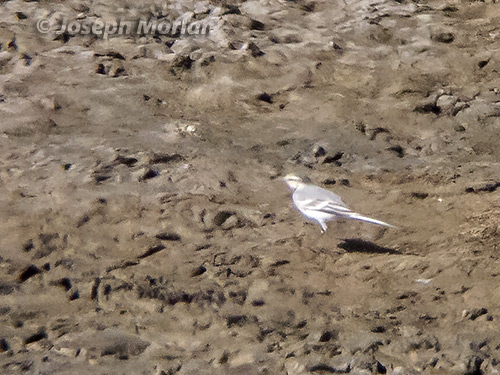White Wagtail (Motacilla alba ocularis)
Rodeo Lagoon, Marin County, CA
20 October 2015
Joseph Morlan
This bird was found in the morning by William Legge and seen throughout the rest of the day as it moved
around the edges of the main lagoon. Robbie Fischer and I arrived in the early afternoon and joined a  group who was viewing the wagtail from
across the lagoon. We then moved to the trail on the south side of the lagoon and spent the next hour studying
the wagtail as it lurched across the mud flat, frequently leaping into the air after flies and actively pumping
its long tail. We were joined by several other birders and photographers. I attempted to digiscope the bird with
the results seen here, but the distance and persistent heat waves produced
rather disappointing results. A
much better photo was taken by Rick LeBaudour.
group who was viewing the wagtail from
across the lagoon. We then moved to the trail on the south side of the lagoon and spent the next hour studying
the wagtail as it lurched across the mud flat, frequently leaping into the air after flies and actively pumping
its long tail. We were joined by several other birders and photographers. I attempted to digiscope the bird with
the results seen here, but the distance and persistent heat waves produced
rather disappointing results. A
much better photo was taken by Rick LeBaudour.
Description
The following description is based on memory and on photos:
An active wagtail with gray mantle including scapulars but with a slightly darker gray crown. The forehead
was white, sometimes appearing to have a faint buff wash which was light dependent. There was a distinct thin line
running from the base of the short thin bill through the eye and across the top of the auriculars. The rest of
the face and underparts were all white except for a modestly broad black bib across the chest. The wings showed
two broad, but rather crisp white wing-bars with little pale fringing on the edges of the greater coverts, lesser
coverts were gray with dark flecking. Tertials appears black with broad white fringes on the edges of the inner
webs, not extending across the feather shaft. The tail was very long and black with the outer two rectrices entirely
white. The scapulars, rump and uppertail coverts were gray, not noticeably darker than the pale gray of the mantle.
Bill seemed fine and short. Legs appeared thin and spindly. Eyes were dark.
Identification
Identification is relatively straightforward. Several similar species are found in parts of Africa and India,
but they have a dark mantle year round and lack the dark transocular stripe of our bird. They are also non-migratory
and have never been recorded in North America. Some plumages of Citrine Wagtail appear largely gray and white but
the face pattern of that species is quite different. Both Yellow and Gray Wagtails have various amounts of yellow
on their underparts as well as other differences.
Discussion
In 1982 the AOU split the White Wagtail into two species, White Wagtail (M. alba) and Black-backed Wagtail
(M. lugens) based on published studies in Russia. However in 2005 the AOU reversed itself and lumped the
two back into a single species White Wagtail (M. alba). This decision was based on the same published studies
which were subsequently thought to be flawed. However Russian authorities still consider them to be separate species
based on lack of hybridization in areas of contact.
Of the various forms of White Wagtail, only two M. a. ocularis and M. a. lugens are known to occur
in California. Both have a distinct transocular line. Adults can be easily separated by wing pattern and back color
but birds in formative plumage can be difficult to identify. In my opinion this individual shows characters consistent
with M. a. ocularis, the form occurring in the Russian Far East and breeding in adjacent Alaska. The pattern of
the wing coverts combined with the dark flight feathers are the strongest field marks. Also worth noting is that
the late October date is consistent with past California records of M. a. ocularis which tends to occur
later in migration than M. a. lugens.
An eBird report attributing this bird to "White Wagtail (Chinese)" is in error. The form there is
M. a. leucopsis which lacks the dark eyeline. It is unrecorded in North America.
 group who was viewing the wagtail from
across the lagoon. We then moved to the trail on the south side of the lagoon and spent the next hour studying
the wagtail as it lurched across the mud flat, frequently leaping into the air after flies and actively pumping
its long tail. We were joined by several other birders and photographers. I attempted to digiscope the bird with
the results seen here, but the distance and persistent heat waves produced
rather disappointing results. A
much better photo was taken by Rick LeBaudour.
group who was viewing the wagtail from
across the lagoon. We then moved to the trail on the south side of the lagoon and spent the next hour studying
the wagtail as it lurched across the mud flat, frequently leaping into the air after flies and actively pumping
its long tail. We were joined by several other birders and photographers. I attempted to digiscope the bird with
the results seen here, but the distance and persistent heat waves produced
rather disappointing results. A
much better photo was taken by Rick LeBaudour.